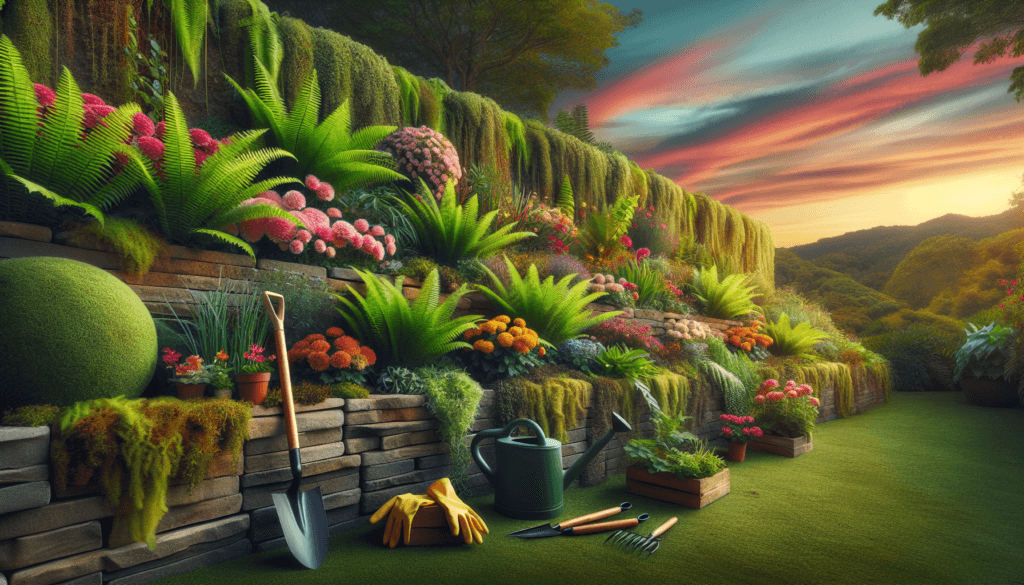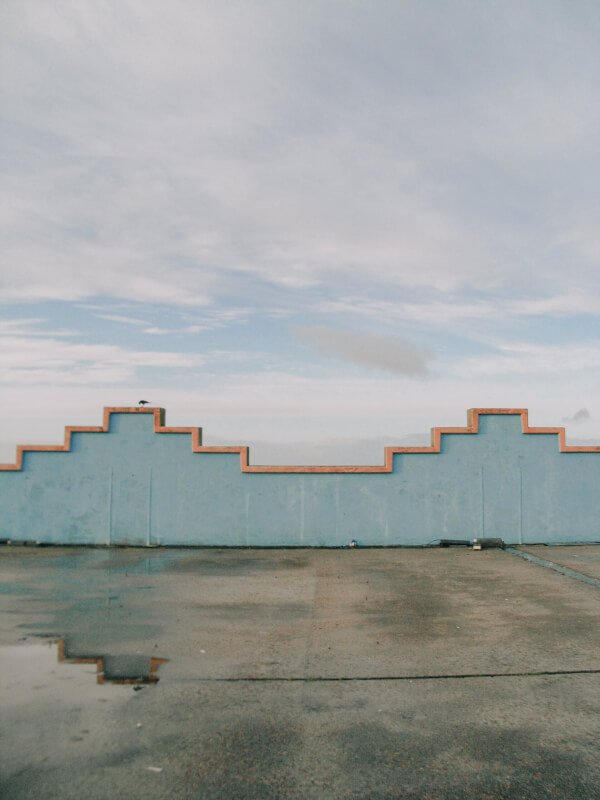Imagine transforming your outdoor space into a stunning oasis with a captivating retaining wall garden. If you’re a DIY enthusiast looking for your next project, we’ve got you covered. In this article, discover the most popular and user-friendly DIY projects for building a retaining wall garden. From step-by-step instructions to handy tips and tricks, you’ll find everything you need to create a beautiful and functional garden that will impress your friends and family. So grab your tools and get ready to unleash your creativity in your very own outdoor sanctuary.

Choosing the Right Location
When it comes to building a retaining wall garden, one of the first things you need to consider is the location. The success of your project depends on finding the right spot that meets the specific needs of your plants. There are a few key factors to consider when choosing the right location for your retaining wall garden.
Considering Soil Conditions
Before you start building your retaining wall garden, it’s important to evaluate the soil conditions in your chosen location. Different plants have different soil preferences, so it’s essential to ensure that the soil is suitable for the types of plants you want to grow. Conduct a soil test to determine its composition and pH level, as this will help you make any necessary amendments to create the ideal growing environment for your plants.
Evaluating Drainage
Another crucial factor to consider is the drainage in your chosen location. Proper drainage is essential for the health and longevity of your plants. You want to avoid building your retaining wall garden in an area where water tends to accumulate or where the soil is consistently soggy. Look for a spot with good natural drainage, or consider implementing a drainage system to prevent water from pooling around the roots of your plants.
Determining Sunlight Exposure
Plants need sunlight to thrive, so it’s important to determine the amount of sunlight your chosen location receives throughout the day. Observe the area to see how many hours of direct sunlight it gets, as this will help you select the appropriate plants for your retaining wall garden. If the area is mostly shaded, you may need to opt for shade-loving plants, while a location with ample sunlight will allow you to grow a wider variety of sun-loving plants.
Materials and Tools Needed
Once you have chosen the perfect location for your retaining wall garden, it’s time to gather the materials and tools you’ll need for the project. Depending on the complexity of your design and your level of expertise, you may need different materials and tools to ensure the success of your DIY project.
Common Materials for Retaining Walls
Some common materials used for retaining walls include concrete blocks, natural stone, bricks, and timber. Each material has its own aesthetic appeal and functional characteristics, so it’s important to choose one that suits your preferences and the overall style of your garden. Consider factors such as durability, affordability, and ease of installation when selecting the material for your retaining wall.
Basic Tools for DIY Projects
For most DIY retaining wall projects, you will need a few basic tools to get started. These include a shovel, wheelbarrow, level, tape measure, rubber mallet, and a hand tamper. These tools will help you excavate the area, level the ground, and construct your retaining wall. Make sure to invest in high-quality tools that are appropriate for the scale of your project to ensure accurate and efficient work.
Optional Tools for Advanced Projects
If you are planning a more advanced retaining wall project, there are additional tools that can make the construction process easier and more efficient. Some optional tools include a power saw for cutting stones or timbers, a plate compactor for compacting the soil and backfill, and a masonry saw for precise cuts on concrete blocks. These tools can save you time and effort, but they are not always necessary for every project.

Preparing the Site
Before you can start building your retaining wall garden, it’s important to properly prepare the site. This involves clearing and leveling the area, removing any vegetation or debris, and marking the layout and dimensions of your retaining wall.
Clearing and Leveling the Area
Start by removing any existing vegetation, rocks, or debris from the area where your retaining wall will be built. Use a shovel and a wheelbarrow to clear away the materials and ensure a clean surface. Once the area is cleared, use a level and a shovel to create a level base. This will provide a solid foundation for your retaining wall.
Removing Vegetation and Debris
Once the area is cleared, it’s important to remove any remaining vegetation and debris that could interfere with the construction process. Remove any grass, weeds, or other plants by hand or using a shovel or a garden hoe. Make sure the area is thoroughly cleared before proceeding with the next steps.
Marking the Layout and Dimensions
After the site is cleared and leveled, it’s time to mark the layout and dimensions of your retaining wall. Use stakes and a string to outline the area where the wall will be built. This will give you a clear visual representation of the size and shape of your retaining wall garden. Double-check your measurements to ensure accuracy and make any necessary adjustments before moving on to the construction phase.
Types of Retaining Walls
When it comes to building a retaining wall garden, there are several types of retaining walls to choose from. Each type has its own unique characteristics and construction methods, so it’s important to understand the differences before deciding which one is right for your project.
Gravity Walls
Gravity walls are one of the most common types of retaining walls. They rely on their own weight and the weight of the soil behind them to provide stability. Gravity walls are typically made of concrete blocks or natural stone, and they require proper engineering and construction techniques to ensure their effectiveness.
Cantilever Walls
Cantilever walls are another popular choice for retaining wall gardens. They are designed with a reinforced concrete base and have a cantilevered portion that extends into the soil. The weight of the soil provides the counterbalance necessary for the wall’s stability. Cantilever walls require careful engineering and construction to ensure their strength and durability.
Sheet Pile Walls
Sheet pile walls are commonly used in areas with soft or loose soil conditions. They consist of interlocking steel or vinyl sheet piles that are driven vertically into the ground. These walls are effective at resisting soil pressure but may require additional waterproofing measures to prevent water seepage.
Anchored Walls
Anchored walls are typically used in situations where high loads or unstable soil conditions are present. They rely on the use of anchors and cables to provide additional support and stability to the retaining wall. Anchors are drilled into the ground and attached to the wall, creating a system that resists lateral soil pressures.

Building a Basic Gravity Wall
Gravity walls are a popular choice for retaining wall gardens due to their simplicity and effectiveness. Here is a step-by-step guide on how to build a basic gravity wall.
Creating a Solid Foundation
Start by excavating a trench for the foundation of your gravity wall. The trench should be wide enough to accommodate the first row of blocks and deep enough to create a stable base. Compact the soil at the bottom of the trench using a hand tamper or a plate compactor. Ensure that the base is level and firm before proceeding to the next step.
Stacking Blocks or Stones
Once the foundation is prepared, start stacking the blocks or stones to create the first row of your gravity wall. Place the blocks or stones tightly together, ensuring that they are level and aligned. Use a level to check the horizontal and vertical alignment of each block or stone. Make any necessary adjustments to ensure a straight and stable wall.
Using Adhesives or Fillers
If you are using concrete blocks, you may choose to use adhesives or fillers to enhance the strength and stability of your gravity wall. Apply construction adhesive between the blocks to bond them together and create a solid structure. Alternatively, you can fill the hollow cores of the blocks with gravel or crushed stone to increase the weight and stability of the wall.
Backfilling and Compacting
Once the first row of blocks is in place and securely set, backfill the area behind the wall with soil. Compact the soil in layers using a hand tamper or a plate compactor to ensure proper compaction and minimize settling. Gradually add additional rows of blocks, repeating the stacking, adhesive application, and backfilling process until the desired height of the wall is reached.
Constructing a Cantilever Wall
Cantilever walls offer a more sophisticated design option for retaining wall gardens. Here is a step-by-step guide on how to construct a cantilever wall.
Excavating a Trench
To begin, excavate a trench for the foundation of your cantilever wall. The trench should be wider and deeper than the desired dimensions of the wall to accommodate the additional width and depth of the reinforced concrete base. Make sure the trench is level and free of any debris before proceeding to the next step.
Installing the First Row of Blocks or Pavers
Once the trench is prepared, start by placing the first row of blocks or pavers at the bottom of the trench. Ensure that they are level and aligned by using a level and a string line as a guide. Make any necessary adjustments to ensure a straight and even base for your cantilever wall.
Adding Reinforcement
Reinforcement is a crucial component of a cantilever wall. Install steel reinforcement bars, also known as rebar, vertically into the trench behind the first row of blocks or pavers. These bars will provide additional strength and stability to the wall. Make sure the rebar is securely positioned and evenly spaced to ensure proper support.
Building Additional Rows
Once the foundation and reinforcement are in place, continue building additional rows of blocks or pavers on top of the first row. Use a level and a string line to ensure proper alignment of each row. Fill the hollow cores of the blocks with gravel or crushed stone to increase the weight and stability of the wall. Repeat this process until the desired height of the cantilever wall is achieved.

Installing a Sheet Pile Wall
Sheet pile walls are a suitable option for areas with soft or loose soil conditions. Here is a step-by-step guide on how to install a sheet pile wall.
Preparing the Soil
Before installing the sheet piles, it’s important to prepare the soil by excavating a trench and creating a level base. Remove any rocks or debris from the trench and compact the soil at the bottom using a hand tamper or a plate compactor. Ensure that the base is firm and level to provide a stable foundation for the sheet pile wall.
Driving the Sheet Piles
Start by driving the first sheet pile into the ground using a pile driver or a hammer. Drive the sheet pile vertically, ensuring it reaches the desired depth to provide sufficient support. Use a level to ensure that the sheet pile is plumb and aligned with the desired wall profile. Repeat this process for subsequent sheet piles, making sure to interlock each sheet pile securely.
Securing Sheet Piles Together
To enhance the stability of the sheet pile wall, secure the sheet piles together by welding, bolting, or using sheet piling connectors. These connectors are designed to interlock the sheet piles and create a continuous wall. Follow the manufacturer’s instructions to ensure proper installation and a secure connection between the sheet piles.
Backfilling the Gap
Once the sheet piles are securely installed and connected, backfill the gap between the sheet pile wall and the excavated trench with soil. Compact the soil in layers to ensure proper compaction and minimize settling. Gradually add additional layers of backfill, compacting each layer before adding the next. Repeat this process until the desired height of the sheet pile wall is achieved.
Creating an Anchored Wall
Anchored walls are commonly used to provide additional support and stability in areas with high loads or unstable soil conditions. Here is a step-by-step guide on how to create an anchored wall.
Drilling Anchoring Holes
To begin, drill anchoring holes into the ground where the wall will be constructed. The number and depth of the holes will depend on the size and scale of your retaining wall. Follow the engineering specifications and guidelines to ensure proper spacing and depth for the anchoring holes.
Inserting Anchors and Cables
Once the anchoring holes are drilled, insert the anchors into the holes. Anchors are typically made of steel and are designed to provide tensile strength to the wall. Attach cables to the anchors and make sure they are securely fastened.
Attaching Anchors to the Wall
After the anchors and cables are in place, position the retaining wall into the designated area. Attach the cables to the wall, ensuring that they are securely fastened. Follow the manufacturer’s instructions for proper attachment and tensioning of the cables.
Finishing the Wall
With the anchors and cables securely attached to the wall, backfill the area behind the retaining wall with soil. Compact the soil in layers to ensure proper compaction and minimize settling. Gradually add additional layers of backfill, compacting each layer before adding the next. Repeat this process until the desired height of the anchored wall is achieved.

Adding Drainage and Irrigation
Proper drainage and irrigation are essential for the health and longevity of your retaining wall garden. Here are some steps to consider when adding drainage and irrigation to your garden.
Installing Drainage Pipes
Incorporating drainage pipes into your retaining wall garden can help prevent water buildup and soggy soil. Install perforated drainage pipes along the back of the wall, ensuring that they slope away from the wall to allow water to flow freely. Connect the pipes to a suitable outlet or drainage system to prevent water from accumulating.
Creating a Drainage Layer
To further enhance drainage, create a drainage layer behind the retaining wall. This layer consists of a coarse gravel or crushed stone material that allows water to drain through easily. Fill the gap between the wall and the excavated trench with the drainage material, ensuring that it is evenly distributed.
Adding Gravel or Stone
In addition to the drainage layer, adding a layer of gravel or decorative stones at the base of your retaining wall garden can help improve drainage and prevent soil erosion. This layer allows excess water to drain away from the plants’ roots, keeping them healthy and preventing waterlogged soil.
Implementing an Irrigation System
To ensure that your plants receive adequate water, consider implementing an irrigation system in your retaining wall garden. This can include drip irrigation, sprinklers, or even a simple hose with a handheld sprayer. Plan the layout of your irrigation system to provide water evenly to the plants, taking into account the specific watering needs of different plant species.
Maintaining and Enhancing the Retaining Wall Garden
Once your retaining wall garden is complete, it’s important to maintain and enhance it to keep it thriving. Here are some tips for maintaining and enhancing your retaining wall garden.
Regular Watering and Fertilizing
Consistent watering is essential for the health of your plants. Monitor the moisture levels in the soil and water accordingly. Provide sufficient water to keep the soil evenly moist but not waterlogged. Additionally, fertilize your plants regularly to provide them with the nutrients they need for optimal growth. Follow the specific fertilization recommendations for the plants in your garden.
Pruning and Trimming
To keep your retaining wall garden looking neat and well-maintained, regularly prune and trim your plants. Remove any dead or damaged foliage, and shape the plants to maintain their desired size and form. Pruning and trimming can promote healthy growth and prevent overcrowding in your garden.
Preventing Erosion and Weed Growth
Retaining walls help prevent erosion, but it’s important to take additional measures to minimize soil erosion and weed growth in your garden. Add mulch to the soil surface around your plants to help retain moisture and prevent weed growth. Additionally, consider using erosion control mats or geotextiles to stabilize the soil and prevent erosion on steep slopes or areas with loose soil.
Integrating Decorative Elements
To enhance the aesthetics of your retaining wall garden, consider integrating decorative elements into your design. Add trellises, arbors, or climbing plants to create vertical interest and provide additional privacy. Incorporate decorative lighting, seating areas, and pathways to make your garden a welcoming and enjoyable space. Personalize your garden with ornaments, sculptures, or unique plant arrangements to reflect your style and personality.
In conclusion, building a retaining wall garden is an exciting and rewarding DIY project. By choosing the right location, gathering the necessary materials and tools, and following the proper construction techniques, you can create a beautiful and functional garden that enhances the aesthetics of your outdoor space. Whether you opt for a gravity wall, cantilever wall, sheet pile wall, or anchored wall, proper preparation and careful execution are key to ensuring the long-term success of your retaining wall garden. Remember to add appropriate drainage and irrigation systems, maintain and enhance your garden regularly, and enjoy the beauty and benefits it brings to your home.


